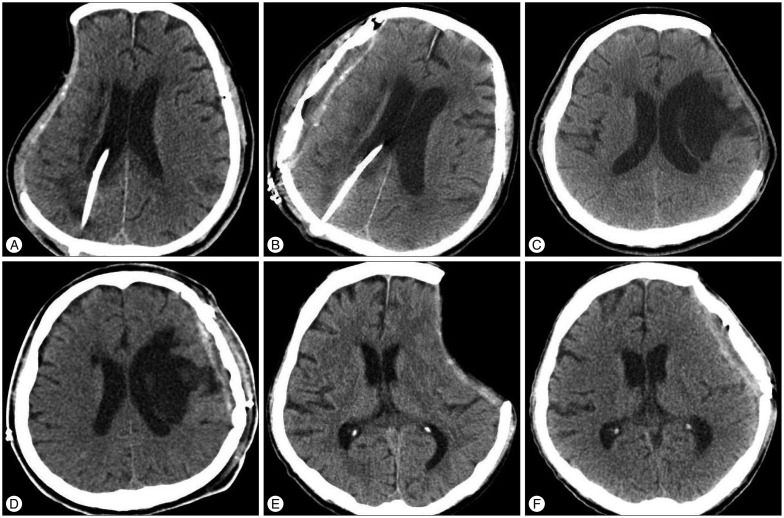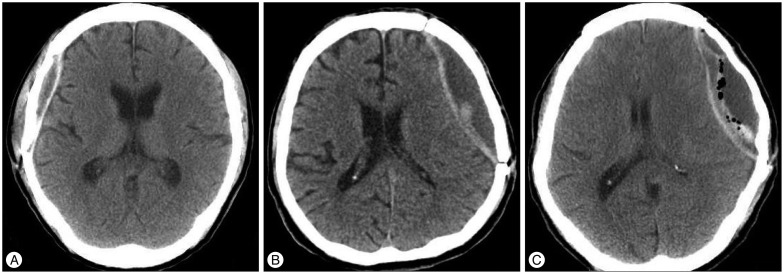J Korean Neurosurg Soc.
2014 Nov;56(5):410-418. 10.3340/jkns.2014.56.5.410.
Clinical Analysis of Epidural Fluid Collection as a Complication after Cranioplasty
- Affiliations
-
- 1Department of Neurosurgery, Seoul Medical Center, Seoul, Korea. kdsyjyw@hotmail.com
- 2Department of Neurosurgery, Hanyang University Guri Hospital, Guri, Korea.
- KMID: 2018100
- DOI: http://doi.org/10.3340/jkns.2014.56.5.410
Abstract
OBJECTIVE
The epidural fluid collection (EFC) as a complication of cranioplasty is not well-described in the literature. This study aimed to identify the predictive factors for the development of EFC as a complication of cranioplasty, and its outcomes.
METHODS
From January 2004 to December 2012, 117 cranioplasty were performed in our institution. One-hundred-and-six of these patients were classified as either having EFC, or not having EFC. The two groups were compared to identify risk factors for EFC. Statistical significance was tested using the t-test and chi-square test, and a logistic regression analysis.
RESULTS
Of the 117 patients undergoing cranioplasty, 59 (50.4%) suffered complications, and EFC occurred in 48 of the patients (41.0%). In the t-test and chi-test, risk factors for EFC were size of the skull defect (p=0.003) and postoperative air bubbles in the epidural space (p<0.001). In a logistic regression, the only statistically significant factor associated with development of EFC was the presence of postoperative air bubbles. The EFC disappeared or regressed over time in 30 of the 48 patients (62.5%), as shown by follow-up brain computed tomographic scan, but 17 patients (35.4%) required reoperation.
CONCLUSION
EFC after cranioplasty is predicted by postoperative air bubbles in the epidural space. Most EFC can be treated conservatively. However, reoperation is necessary to resolve about a third of the cases. During cranioplasty, special attention is required when the skull defect is large, since EFC is then more likely.
Figure
Cited by 2 articles
-
Initial Dead Space and Multiplicity of Bone Flap as Strong Risk Factors for Bone Flap Resorption after Cranioplasty for Traumatic Brain Injury
Jeong Kyun Joo, Jong-Il Choi, Chang Hyun Kim, Ho Kook Lee, Jae Gon Moon, Tack Geun Cho
Korean J Neurotrauma. 2018;14(2):105-111. doi: 10.13004/kjnt.2018.14.2.105.Efficacy of Anti-Adhesive Substitute and Step-by-Step Techniques in Decompressive Craniectomy and Subsequent Cranioplasty
You-Sub Kim, Jae-Woong Kim, Sung-Pil Joo, Tae-Sun Kim
J Korean Neurosurg Soc. 2025;68(3):360-368. doi: 10.3340/jkns.2024.0176.
Reference
-
1. Albanèse J, Leone M, Alliez JR, Kaya JM, Antonini F, Alliez B, et al. Decompressive craniectomy for severe traumatic brain injury : evaluation of the effects at one year. Crit Care Med. 2003; 31:2535–2538. PMID: 14530763.
Article2. Beauchamp KM, Kashuk J, Moore EE, Bolles G, Rabb C, Seinfeld J, et al. Cranioplasty after postinjury decompressive craniectomy : is timing of the essence? J Trauma. 2010; 69:270–274. PMID: 20699735.
Article3. Bullock MR, Chesnut R, Ghajar J, Gordon D, Hartl R, Newell DW, et al. : Surgical management of acute subdural hematomas. Neurosurgery. 2006; 58(3 Suppl):S16–S24. discussion Si-Siv. PMID: 16710968.4. Chang V, Hartzfeld P, Langlois M, Mahmood A, Seyfried D. Outcomes of cranial repair after craniectomy. J Neurosurg. 2010; 112:1120–1124. PMID: 19612971.
Article5. Cho KC, Park SC, Choe IS, Seo DH. Safety and efficacy of early cranioplasty after decompressive craniectomy in traumatic brain injury patients. J Korean Neurotraumatol Soc. 2011; 7:74–77.
Article6. Chun HJ, Yi HJ. Efficacy and safety of early cranioplasty, at least within 1 month. J Craniofac Surg. 2011; 22:203–207. PMID: 21233757.
Article7. Cooper DJ, Rosenfeld JV, Murray L, Arabi YM, Davies AR, D'Urso P, et al. Decompressive craniectomy in diffuse traumatic brain injury. N Engl J Med. 2011; 364:1493–1502. PMID: 21434843.
Article8. Gooch MR, Gin GE, Kenning TJ, German JW. Complications of cranioplasty following decompressive craniectomy : analysis of 62 cases. Neurosurg Focus. 2009; 26:E9. PMID: 19485722.9. Lee JW, Kim JH, Kang HI, Moon BG, Lee SJ, Kim JS. Epidural fluid collection after cranioplasty : fate and predictive factors. J Korean Neurosurg Soc. 2011; 50:231–234. PMID: 22102954.
Article10. Liang W, Xiaofeng Y, Weiguo L, Gang S, Xuesheng Z, Fei C, et al. Cranioplasty of large cranial defect at an early stage after decompressive craniectomy performed for severe head trauma. J Craniofac Surg. 2007; 18:526–532. PMID: 17538313.
Article11. Liao CC, Kao MC. Cranioplasty for patients with severe depressed skull bone defect after cerebrospinal fluid shunting. J Clin Neurosci. 2002; 9:553–555. PMID: 12383414.
Article12. Moreira-Gonzalez A, Jackson IT, Miyawaki T, Barakat K, DiNick V. Clinical outcome in cranioplasty : critical review in long-term follow-up. J Craniofac Surg. 2003; 14:144–153. PMID: 12621283.13. Oh CH, Park CO, Hyun DK, Park HC, Yoon SH. Comparative study of outcomes between shunting after cranioplasty and in cranioplasty after shunting in large concave flaccid cranial defect with hydrocephalus. J Korean Neurosurg Soc. 2008; 44:211–216. PMID: 19096679.
Article14. Park JS, Lee KS, Shim JJ, Yoon SM, Choi WR, Doh JW. Large defect may cause infectious complications in cranioplasty. J Korean Neurosurg Soc. 2007; 42:89–91.15. Piedra MP, Ragel BT, Dogan A, Coppa ND, Delashaw JB. Timing of cranioplasty after decompressive craniectomy for ischemic or hemorrhagic stroke. J Neurosurg. 2013; 118:109–114. PMID: 23140156.
Article16. Schuss P, Vatter H, Marquardt G, Imöhl L, Ulrich CT, Seifert V, et al. Cranioplasty after decompressive craniectomy : the effect of timing on postoperative complications. J Neurotrauma. 2012; 29:1090–1095. PMID: 22201297.
Article17. Simard JM, Sahuquillo J, Sheth KN, Kahle KT, Walcott BP. Managing malignant cerebral infarction. Curr Treat Options Neurol. 2011; 13:217–229. PMID: 21190097.
Article18. Smith ER, Carter BS, Ogilvy CS. Proposed use of prophylactic decompressive craniectomy in poor-grade aneurysmal subarachnoid hemorrhage patients presenting with associated large sylvian hematomas. Neurosurgery. 2002; 51:117–124. discussion 124. PMID: 12182408.
Article19. Sobani ZA, Shamim MS, Zafar SN, Qadeer M, Bilal N, Murtaza SG, et al. Cranioplasty after decompressive craniectomy : an institutional audit and analysis of factors related to complications. Surg Neurol Int. 2011; 2:123. PMID: 22059118.
Article20. Stephens FL, Mossop CM, Bell RS, Tigno T Jr, Rosner MK, Kumar A, et al. Cranioplasty complications following wartime decompressive craniectomy. Neurosurg Focus. 2010; 28:E3. PMID: 20568943.
Article21. Timmons SD, Ullman JS, Eisenberg HM. Craniectomy in diffuse traumatic brain injury. N Engl J Med. 2011; 365:373. author reply 376. PMID: 21793755.
Article
- Full Text Links
- Actions
-
Cited
- CITED
-
- Close
- Share
- Similar articles
-
- Epidural Fluid Collection after Cranioplasty : Fate and Predictive Factors
- Symptomatic Epidural Fluid Collection Following Cranioplasty after Decompressive Craniectomy for Traumatic Brain Injury
- Delayed Infection Following Cranioplasty: Review of 4 Cases
- A Clinical Analysis of Cranioplasty Using Methyl Methacrylate
- Autogenous Cranioplasty Using Deep-Freezing Bone Flap




